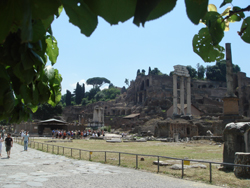The Castle at Burgdorf was the largest castle ever built by the Dukes of Zähringen and dates from the 12th Century. The museum it now houses dates
from 1886 and was founded by Rittersallverein Burgdorf.
The location of the castle is down to its location as the
entry to the more mountainous region of Emmental.
There have, apparently, been pre-historic finds which indicate
a permanent settlement at Burgdorf before Roman Times.
According to legend, two Counts of Lenzburg Sintram and Bertram
defeated the local dragon and, in the process, won the prominent
sandstone cliff above the Emme on which they built their castle.
The first mention of the castle, however, was in 1175. Burgdorf
town was probably only founded towards the end of the 12th
Century and extended again at the end of the 13th Century.
Burgdorf came into the possession of the the Count of Kyburg
when Berthold V died heirless
in 1218 and the Zähringen house died with him. When the
Counts of Kyburg died out, Count Rudolf of Hapsburg intisgated
the House of Kyburg-Burgdorf. In around 1300, the lower part
of Burgdorf was enclosed so that trade and industry could develop
around the water from the stream and water-wheels were installed.
In time, with the decline of the Counts and the rise of Burgdorfs
industry and commerce the towm was able to buy certain rights
from the Counts.
Following a war from 1382 to 1384, Bernese and Swiss Confederate
troops unsuccesfully sieged the town and castle. Despite the
victory the counts had to sell the town, castle and their estates
in
Thun
to
Berne
As
Berne
owned Burgdorf from 1384, a Bernese governement representative
in the form of a mayor resided in the castle.
Burgdorf flourished again in the late middle ages as a result
of tanning and the weaving of wool and linen.
Between 1471 and 1490, the late-Gothic Church
was built.
The Construction of the railway in 1857 allowed Burgdorf
to integrate further with the outside would and factories,
workers houses and indusrialist mansions emerged in the area.
The town was extensivly rebuilt following the Great Fire of
1865. In 1891, the Cantonal College of Technology was founded
in Burgdorf.
 My personal advise on what to do and see in Rome
My personal advise on what to do and see in Rome
 Mt Egmont seen from the King Edward Park playing fields in Stratford
Mt Egmont seen from the King Edward Park playing fields in Stratford
 The Stratford Glockenspeil in Taranaki
The Stratford Glockenspeil in Taranaki
 The Antelope - your local, dog friendly, beer friendly pub
The Antelope - your local, dog friendly, beer friendly pub
 Must see ancient monuments around Rome
Must see ancient monuments around Rome
 Historical information about the gothic Antwerp Cathedral
Historical information about the gothic Antwerp Cathedral
 What to see, where to stay and eat in historic Antwerp
What to see, where to stay and eat in historic Antwerp
 Recommended hotels in Vienna, Salzburg and Bregenz
Recommended hotels in Vienna, Salzburg and Bregenz